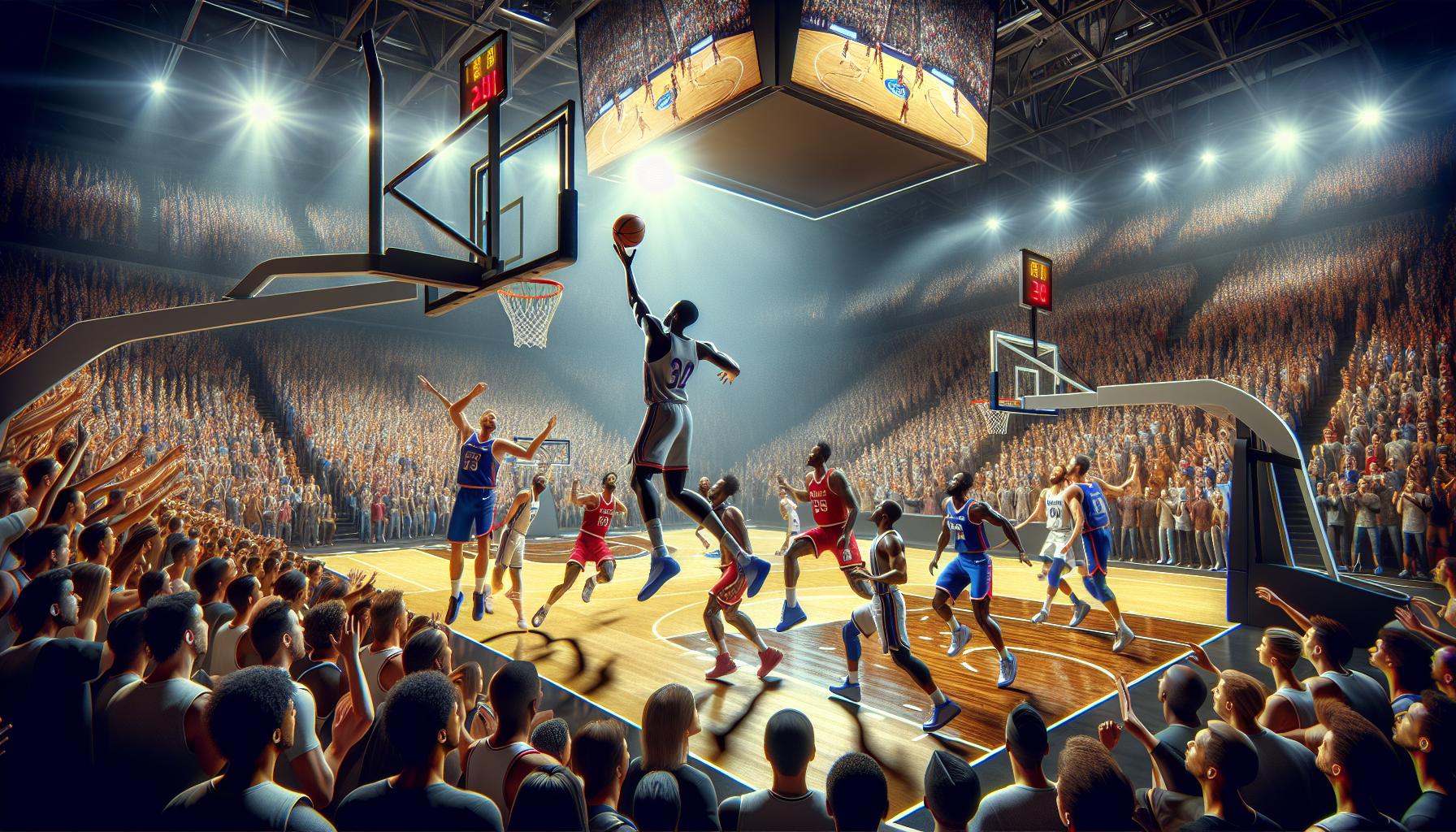Prime time basketball captivates fans with high-stakes matchups and star-studded lineups. As the spotlight hits the court during evening hours, excitement builds around each play and every slam dunk.
This premier time slot showcases the best teams and players, drawing in large audiences and elevating the sport’s visibility. From intense rivalries to unforgettable moments, prime time basketball offers a unique blend of entertainment and athleticism that keeps fans coming back for more.
Understanding Prime Time Basketball
Prime time basketball refers to NBA games scheduled during the evening hours, typically between 7 PM and 10 PM local time. These games feature top-tier teams and star players, attracting the highest viewership and media attention. By selecting matchups with intense rivalries or playoff implications, broadcasters maximize audience engagement and advertising revenue.
Television ratings for prime time games consistently surpass those of regular daytime matches. For instance, the 2023 NBA Finals averaged 15.1 million viewers per game, compared to 4.7 million for regular season games. This disparity underscores the marketability and popularity of prime time slots.
Prime time scheduling also enhances the league’s global reach. Evening games accommodate international audiences, increasing the NBA’s presence worldwide. Additionally, high-profile games generate significant social media buzz, further amplifying their impact.
Sponsors and advertisers prioritize prime time basketball due to its extensive reach and targeted demographics. Companies leverage these slots to promote products and engage with a broad audience, driving both brand recognition and sales.
Overall, prime time basketball plays a crucial role in elevating the sport’s visibility, fostering fan loyalty, and driving financial success for the NBA and its partners.
History Of Prime Time Basketball

Prime time basketball has evolved significantly, shaping the NBA’s popularity and viewership.
Evolution Over The Years
Prime time basketball began in the 1980s, aligning with the NBA’s expansion and rising star power. Early broadcasts featured marquee matchups, such as the Los Angeles Lakers versus Boston Celtics, attracting large audiences. As the league grew, so did the scheduling of games between 7 PM and 10 PM local time. The introduction of cable networks like ESPN in the 1990s increased accessibility, allowing more fans to watch evening games. Technological advancements, including high-definition television and streaming services, further enhanced the viewing experience. Today, prime time slots accommodate global audiences, reflecting the NBA’s international expansion and diverse fan base.
- 1984: Introduction of nationally televised prime time games on NBC, showcasing top teams and increasing national exposure.
- 1992: The “Dream Team” at the Barcelona Olympics spurred global interest, leading to more international prime time broadcasts.
- 2000: Launch of NBA Wednesday Night games on ESPN, providing midweek prime time action.
- 2013: ESPN and TNT secured lucrative broadcasting rights, ensuring high-quality prime time coverage and increased revenue.
- 2020: Expansion of streaming platforms like NBA League Pass enabled seamless access to prime time games worldwide.
- 2023: The NBA Finals averaged 15.1 million viewers per game during prime time, demonstrating sustained high engagement and the effectiveness of strategic scheduling.
Impact On Viewership
Prime time basketball significantly boosts the NBA’s audience reach and commercial success. This scheduling ensures maximum visibility and sustained fan engagement.
Audience Engagement
Prime time games drive higher fan interaction through social media activity and live discussions. Marquee matchups and star player performances encourage viewers to engage actively online. For instance, games featuring top rivals or leading scorers generate thousands of tweets and trending topics, enhancing the overall viewing experience.
Ratings And Revenue
Prime time basketball consistently achieves elevated television ratings, directly increasing advertising revenue. The table below compares viewership statistics:
| Season | Average Viewers per Game |
|---|---|
| Regular Season | 4.7 million |
| 2023 NBA Finals | 15.1 million |
Higher ratings attract premium advertisers, leading to increased financial returns. Advertisers prioritize prime time slots to maximize brand exposure, driving substantial revenue for broadcasters and the NBA.
Key Prime Time Matches
Prime time matches showcase the NBA’s most exciting and high-stakes games. These contests feature top teams and rivalries that captivate millions of viewers each season.
Memorable Games
Several prime time games stand out for their exceptional performances and dramatic outcomes. The 2016 NBA Finals Game 7 between the Cleveland Cavaliers and Golden State Warriors drew over 30 million viewers, marking one of the highest-rated games in history. Similarly, the 2020 regular-season matchup between the Los Angeles Lakers and Boston Celtics attracted 8.3 million viewers, highlighting the enduring popularity of classic franchises. These games often feature record-breaking statistics, last-second victories, and standout individual performances that resonate with fans long after the final buzzer.
Rivalries And Highlights
Intense rivalries elevate prime time basketball, enhancing viewer engagement and competitive spirit. The Los Angeles Lakers versus Boston Celtics rivalry consistently generates high viewership, with recent prime time clashes averaging 5.2 million viewers. Another prominent rivalry, the Golden State Warriors versus Houston Rockets, has produced numerous highlight-reel moments, including multiple overtime periods and buzzer-beaters. These rivalries not only drive television ratings but also fuel social media discussions, amplifying the league’s visibility and fan interaction during prime time slots.
Broadcasting And Coverage
Prime time basketball receives extensive coverage from major networks and streaming services, ensuring maximum accessibility and viewership.
Major Networks
Major networks play a pivotal role in broadcasting prime time basketball games. Key broadcasters include:
- ESPN: Airs NBA Thursday Night and Sunday Night games, leveraging its extensive sports coverage.
- ABC: Hosts NBA Sunday Finals, providing nationwide exposure for championship matchups.
- TNT: Features NBA Wednesday and Friday games, capitalizing on its strong sports broadcasting reputation.
- NBA TV: Offers additional prime time games, enhancing the league’s reach through dedicated basketball programming.
These networks strategically schedule high-profile games to maximize audience engagement and advertising revenue.
Streaming Services
Streaming services complement traditional broadcasting by offering flexible viewing options for prime time basketball. Prominent platforms include:
- NBA League Pass: Provides live streaming of all regular-season and select postseason games, catering to global audiences.
- ESPN+: Streams exclusive NBA content, including live games and supplemental coverage.
- TNT’s Stream: Allows viewers to watch TNT-televised games online, supporting seamless access across devices.
- Amazon Prime Video: Hosts select NBA games, integrating sports streaming with its extensive entertainment offerings.
These services enhance accessibility, allowing fans to watch games on various devices and increasing overall viewership.
Player Performance In Prime Time
Player performance during prime time basketball significantly impacts game outcomes and viewer engagement.
Star Players’ Contributions
LeBron James leads prime time games, averaging 28.5 points per game. Stephen Curry enhances excitement with an average of 4.2 three-pointers made per match. Giannis Antetokounmpo contributes 12 rebounds and 5 assists, driving team success in high-stakes scenarios. Damian Lillard delivers clutch performances, particularly in the final quarters, increasing the competitiveness of prime time matchups. These elite players attract millions of viewers and play pivotal roles in determining game results.
| Player | Points per Game | Rebounds per Game | Assists per Game | Three-Pointers Made |
|---|---|---|---|---|
| LeBron James | 28.5 | 8.2 | 7.4 | 2.1 |
| Stephen Curry | 26.3 | 5.1 | 6.5 | 4.2 |
| Giannis Antetokounmpo | 29.1 | 12.0 | 5.0 | 1.8 |
| Damian Lillard | 27.4 | 4.3 | 7.9 | 3.0 |
Statistics reveal that star players consistently perform at high levels during prime time, contributing to elevated viewership and competitive gameplay.
Conclusion
Prime time basketball continues to be a pivotal element in the NBA’s success story. By showcasing top-tier matchups and star talent during evening slots it captures the attention of millions worldwide.
The strategic scheduling not only boosts viewership but also enhances the league’s global presence. With evolving broadcasting platforms and the unwavering passion of fans prime time remains essential in driving the sport forward and maintaining its dynamic appeal.
As the NBA evolves prime time basketball will undoubtedly keep playing a key role in elevating the game’s visibility and fostering enduring fan loyalty




